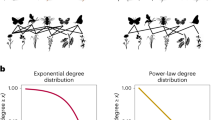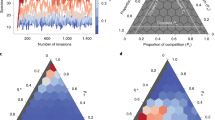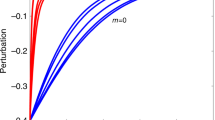Abstract
Arising from A. James, J. W. Pitchford & M. J. Plank Nature 487, 227–230 (2012)10.1038/nature11214
Analytical research indicates that the ‘nestedness’ of mutualistic networks facilitates the coexistence of species by minimizing the costs of competition relative to the benefits of facilitation1. In contrast, James et al.2 recently argued that a more parsimonious explanation exists: the persistence of a community and its constituent species depends more on their having many interactions (high connectance and high degree, respectively) than for these interactions to be organized in any particular manner. Here we demonstrate that these conclusions are an unintended consequence of the fact that the methodology of ref. 2 directly changed the number of interactions of each species—and hence their expected persistence. When these changes are taken into account, we find a significant, positive relationship between nestedness and network persistence that reconfirms the importance of nestedness in mutualistic communities1,3. There is a Reply to this Brief Communication Arising by James, A., Pitchford, J. W. & Plank, M. J. Nature 500, http://dx.doi.org/10.1038/nature12381 (2013).
This is a preview of subscription content, access via your institution
Access options
Subscribe to this journal
Receive 51 print issues and online access
$199.00 per year
only $3.90 per issue
Buy this article
- Purchase on Springer Link
- Instant access to full article PDF
Prices may be subject to local taxes which are calculated during checkout

Similar content being viewed by others
References
Bastolla, U. et al. The architecture of mutualistic networks minimizes competition and increases biodiversity. Nature 458, 1018–1020 (2009)
James, A., Pitchford, J. W. & Plank, M. J. Disentangling nestedness from models of ecological complexity. Nature 487, 227–230 (2012)
Thébault, E. & Fontaine, C. Stability of ecological communities and the architecture of mutualistic and trophic networks. Science 329, 853–856 (2010)
Jordano, P., Bascompte, J. & Olesen, J. M. Invariant properties in coevolutionary networks of plant-animal interactions. Ecol. Lett. 6, 69–81 (2003)
Fortuna, M. A. et al. Nestedness versus modularity in ecological networks: two sides of the same coin? J. Anim. Ecol. 79, 811–817 (2010)
Saavedra, S., Stouffer, D. B., Uzzi, B. & Bascompte, J. Strong contributors to network persistence are the most vulnerable to extinction. Nature 478, 233–235 (2011)
Stouffer, D. B., Camacho, J., Guimerà, R., Ng, C. A. & Amaral, L. A. N. Quantitative patterns in the structure of model and empirical food webs. Ecology 86, 1301–1311 (2005)
Rezende, E. L., Lavabre, J. E., Guimarães, P. R., Jordano, P. & Bascompte, J. Non-random coextinctions in phylogenetically structured mutualistic networks. Nature 448, 925–928 (2007)
Almeida-Neto, M., Guimarães, P., Guimarães, P. R., Jr, Loyola, R. D. & Urlich, W. A consistent metric for nestedness analysis in ecological systems: reconciling concept and measurement. Oikos 117, 1227–1239 (2008)
Ulrich, W., Almeida-Neto, M. & Gotelli, N. J. A consumer’s guide to nestedness analysis. Oikos 118, 3–17 (2009)
Gotelli, N. J. & Ulrich, W. Statistical challenges in null model analysis. Oikos 121, 171–180 (2012)
Williams, R. J. Biology, methodology or chance? the degree distributions of bipartite ecological networks. PLoS ONE 6, e17645 (2011)
Allesina, S. Ecology: the more the merrier. Nature 487, 175–176 (2012)
Bascompte, J. & Jordano, P. The structure of plant-animal mutualistic networks: the architecture of biodiversity. Annu. Rev. Ecol. Evol. Syst. 38, 567–593 (2007)
Zuur, A., Ieno, E. N., Walker, N., Saveiliev, A. A. & Smith, G. M. Mixed Effects Models and Extensions in Ecology with R (Springer, 2009)
Author information
Authors and Affiliations
Contributions
S.S. and D.B.S. designed the study, performed the simulations, analysed the data and wrote the manuscript.
Corresponding author
Ethics declarations
Competing interests
Declared none.
PowerPoint slides
Rights and permissions
About this article
Cite this article
Saavedra, S., Stouffer, D. “Disentangling nestedness” disentangled. Nature 500, E1–E2 (2013). https://doi.org/10.1038/nature12380
Received:
Accepted:
Published:
Issue Date:
DOI: https://doi.org/10.1038/nature12380
This article is cited by
-
Invasive Asteraceae plants can enhance community stability by changing pollination network structure, yet cause intense pollen disturbance to native plants in an oceanic island community
Biological Invasions (2023)
-
Plant-pollinator networks in Australian urban bushland remnants are not structurally equivalent to those in residential gardens
Urban Ecosystems (2021)
-
Sex peptide receptor-regulated polyandry modulates the balance of pre- and post-copulatory sexual selection in Drosophila
Nature Communications (2019)
-
The joint influence of competition and mutualism on the biodiversity of mutualistic ecosystems
Scientific Reports (2018)
-
Effect of localization on the stability of mutualistic ecological networks
Nature Communications (2015)
Comments
By submitting a comment you agree to abide by our Terms and Community Guidelines. If you find something abusive or that does not comply with our terms or guidelines please flag it as inappropriate.



